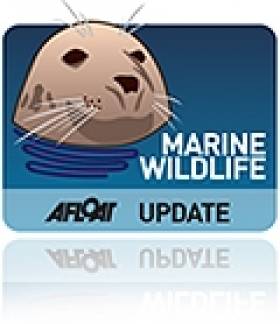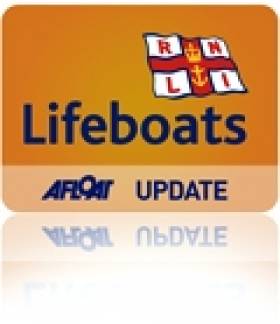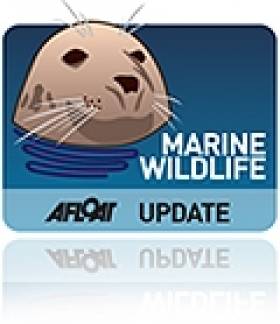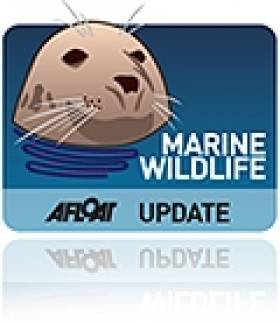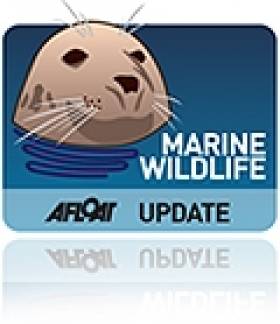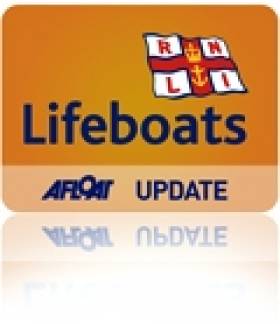Displaying items by tag: Baltimore
Baltimore Whale Remains Dumped At Sea
#MARINE WILDLIFE - The carcass of the fin whale that died after being trapped in Baltimore Harbour two months ago has been towed out to sea after its presence in a conservation area attracted complaints.
According to the Irish Examiner, disappointment has been expressed by a local group in Baltimore who hoped to salvage the skeleton of the 65ft female fin whale, the remains of which have now been towed out beyond Fastnet Rock for disposal.
Last week Afloat.ie reported on claims from local resident Tom McCarthy, among others from the Schull area, that the whale carcass was creating a "rancid oil slick" with a "horrendous smell" in Roaringwater Bay, a Special Area of Conservation for marine wildlife that houses a grey seal breeding ground.
However, the Irish Whale and Dolphin Group (IWDG) - which was working with Baltimore residents on their plan to retrieve the bones with a view to displaying the skeleton in the town - criticised the decision by Cork County Council to dump the remains.
IWDG sightings co-ordinator Pádraig Whooley pointed the finger at "vested interests" exaggerating claims about health hazards, arguing that "towing it out to sea raises the very real possibility that [it] could simply wash up on the coast again."
The Irish Examiner has more on the story HERE.
Baltimore Whale Carcass Creating 'Rancid Oil Slick' in Conservation Area
#BALTIMORE WHALE - Nine weeks after the tragic demise of the Baltimore Harbour fin whale, its carcass is still afloat off West Cork, creating a “rancid oil slick” in a special conservation area, according to a local resident.
Tom McCarthy contacted Afloat.ie with the above image of the 65ft whale carcass, which was towed out to the grey seal breeding ground off the Carthys Islands in Roaringwater Bay and has apparently been left to rot.
“It has been left here since the middle of August to decay,” says Tom. “The rancid oil slick is clearly visible and extends for over 1km on relatively still days, the smell is horrendous."
As previously reported on Afloat.ie, plans were afoot to sink the fin whale carcass that was trapped in Baltimore Harbour in mid-August and endured a harrowing few days trapped in Baltimore Harbour before it died from what's presumed to be a combination of illness and injury.
Tom McCarthy claims that the National Parks and Wildlife Service (NPWS) has washed its hands of the situation, considering the enormous marine mammal carcass to be a natural occurrence "even though the animal beached and died several miles [away and] was wrapped in a net and towed to its final resting position".
The location is in a Special Area of Conservation - yet according to Tom, no risk assessment appears to have been carried out beforehand.
"Ten minutes on the internet would show that whales are perhaps the most contaminated animals in the world," he says. "Their blubber is contaminated with persistent organic compounds such as PCBs, DDT, dioxins, etc and the internal organs such as the liver and kidneys are 'high', 'very high' or 'staggeringly high' in mercury, cadmium, chromium, etc.
"Some beached whales are found to be so contaminated the whale itself has to be considered as hazardous waste and disposed of as such."
Tom notes that the area is fished extensively for shrimp, crab, lobster and pollock, and that the rotting carcass is in close proximity to several mussel farms.
"It seems inevitable that as the whale continues to decay and is eaten whatever contaminants were present prior to death will re-enter the food chain."
He compares the current situation to a similar whale carcass disposal in Sligo last year, where the flesh was cut off and sent for incineration while the bones were marked for later skeletal recreation and sent for composting.
Regarding the West Cork whale carcass, Tom says: "Some estimates say it will take three years for the whale to completely decay."
Tom adds that he has been in contact with Cork County Council and hopes to hear on Monday about plans for a more appropriate method of disposal for the whale carcass.
New Tamar Lifeboat Named in Baltimore
#rnli – Baltimore RNLI have officially named the new €3m Tamar class lifeboat Alan Massey at a harbour ceremony yesterday.
The lifeboat was substantially funded by a legacy from Ms Dorothy May Massey in honour of her late brother Alan. It was named by Mrs Sue Windsor, a close family friend of Ms Massey, before being handed over to Baltimore RNLI.
Mr. Declan Tiernan, Chairperson of the Baltimore Lifeboat Station stated that the lifeboat has already proved its worth. He told the crowd about a recent callout which involved the new lifeboat and its Y boat (an inflatable boat carried on the deck of the lifeboat). Last month two teenagers were trapped in a cave and conditions were making it impossible for rescuers to get close, the lifeboat crew deployed the small Y boat from the lifeboat to bring the lifeboat volunteers as far into the narrow cave as they could safely go before a crewmember then swam the rest of the way and brought them to safety.
RNLI Operations Director Michael Vlasto OBE, who travelled to Baltimore to accept the lifeboat into the care of the Institution commented, " Baltimore's lifeboats have a proud history of lifesaving dating back to 1919 and since then have launched 718 times and in so doing have rescued 661 people. Ten medals have been awarded, the last being voted in 1992 to the current Coxswain Kieran Cotter.
In the RNLI, the safety of our volunteer crew is paramount. We strive to ensure they have the best lifeboats, excellent training and first class equipment to carry out their often difficult tasks. This Tamar lifeboat is state of the art and has proven to be a thoroughly reliable and capable lifesaving craft since its arrival here at Baltimore."
Tom Bushe, Baltimore RNLI Lifeboat Operations Manager accepted the lifeboat into the care of the Baltimore Lifeboat station. The new lifeboat has already launched 14 times and rescued 17 people since its arrival in February. Tom added, " We are very proud to be the custodians of this lifeboat. The crew in Baltimore provide an exceptional service to their community. These are ordinary people who are ready to risk their own lives in the service of others."
The lifeboat was officially named in the traditional way of breaking a bottle of champagne over the bow.Mrs Sue Windsor then named the lifeboat Alan Massey.
Ms Dorothy May Massey was born in 1906 and lived in Watford. She was the youngest of three children. It was her wish to fund a lifeboat and she passed away in 2003 aged 97. The Baltimore Tamar lifeboat has been substantially funded by her legacy together with the generous bequests of Henry and Joan Jermyn, John Noel Harvey Ward and John Heath.
The new Tamar class lifeboat is 16.3 metres in length with a maximum speed of 25 knots compared to the 14.3 metres of Baltimore RNLI's former Tyne class lifeboat, which had a maximum speed of 18 knots. The lifeboat is self-righting and is fitted with an integrated electronics systems and information management system, which allows the lifeboat crew to monitor, operate and control many of the boats systems from shock mitigating seats. It has room for 44 survivors.
The event included local school children from Rath National School who sang the lifeboat anthem Home from the Sea and groups and musicians including the Rathmore Church Choir, The Baltimore Singers and HX Brass.
Surface Search for Missing Diver Winds Down
#MISSING DIVER - Teams were still searching yesterday at a wreck site off Cape Clear for a diver missing since Tuesday, according to The Irish Times.
A Defence Forces spokesperson told the paper that a sonar device would be employed to scan the seabed for any sign of 54-year-old Reinhardt Teschke, who failed to resurface from a 90m dive on the wreck of British merchant vessel the Minnehaha.
As previously reported on Afloat.ie, Baltimore RNLI launched both its inshore and all-weather lifeboats to the scene south of Balitmore Harbour in West Cork on Tuesday evening to search for the German diver, one of a party of three at the wreck site.
Irish Coast Guard helicopter Rescue 115 and the Naval Service vessel LE Ciara were also involved in the surface search, which was set to be wound down yesterday.
Search Resumes for Missing Wreck Diver off Baltimore
#rnli – Baltimore Lifeboat have resumed a search for a missing diver this morning at a wreck site south of Baltimore Harbour in West Cork.
Both the inshore lifeboat and all weather lifeboat were launched yesterday evening in response to a request from the coastguard to assist in locating a diver reported missing earlier in the afternoon.
The diver had been one of a party of three diving at a wreck site 12 miles south of Baltimore Harbour. The divers are reported by the RNLI to be of German and the dive site the wreck of the Minnehaha.
Weather conditions were excellent with a 1.5 metre swell and force 3-4 winds. The Navy vessel LE Ciara, Coastguard Helicopter 115 and the Holly Joe were all involved in the search.
As darkness approached last night the inshore lifeboat (ILB) was stood down and returned to Baltimore at 21.10 approx. Onboard the B-class ILB Bessie, were Helm Youen Jacob, Shane MacSweeney and Ger O'Brien. On board the Tamar class ALB Alan Massey, were Coxswain Kieran Cotter, Cathal Cottrell (mechanic), John Rochford, Brian MacSweeney, Jerry Smith and Aidan Bushe.
Samples Taken from Baltimore Fin Whale Carcass
#MARINE WILDLIFE - The Irish Examiner reports that samples from the fin whale that stranded and died in Baltimore Harbour last week have been sent to Dublin for analysis.
Samples of skin and blubber will be tested by marine science experts at the Irish Cetacean Tissue Bank in the Natural History Museum as well as at the Marine Institute, while a student studying for a PhD on the feeding ecology of fin whales will also examine the remains.
As reported yesterday on Afloat.ie, the whale carcass has been towed out of the inner harbour as preparations are made to sink it to the seabed, where marine life such as fish and crabs will quickly strip it down to a skeleton that locals hope to put on display in the West Cork town.
A post-mortem will not be carried out by the Irish Whale and Dolphin Group (IWDG) due to lack of funding for the specialised procedure. A previous necropsy of a fin whale stranded at Courtmacsherry was funded by the US-based magazine National Geographic.
Plans to Sink Baltimore Whale Carcass and Retrieve Its Skeleton
#MARINE WILDLIFE - Plans are afoot to sink the carcass of the fin whale that died after being trapped in Baltimore Harbour last week, according to the Irish Independent.
It is being proposed that the whale's body can be wrapped in netting and sunk using old train wheels as weights.
"We're looking at putting it in the water and letting it sink to the seabed where the fish and crabs can do their work and strip the flesh from the carcass," said local diver Jerry Smith. "The end scenario would be to retrieve the skeleton from the sea bed."
It's hoped that the skeleton of the 65ft female juvenile fin whale could eventually be put on display as an educational aid and a tourist attraction for the West Cork town.
Cork County Council has taken responsibility for the disposal, as the Cork Independent reports, and the 30-tonne marine giant has already been towed to Oldcourt in the Ilen esturary.
As previously reported on Afloat.ie, calls have been made to introduce a new protocol to deal with large marine wildlife strandings.
The Irish Whale and Dolphin Group (IWDG) defended itself from criticism over the handing of the "unprecedented" incident, arguing that allowing the whale to die was the best option available under the circumstances.
The Irish Independent has more on the story HERE.
Call for Whale Stranding Protocol After Baltimore Incident
#MARINE WILDLIFE - The Cork News reports that a new protocol will be introduced to deal with large marine wildlife strandings following the public backlash over the handling of the injured and malnourished fin whale in Baltimore Harbour this week.
The 30-tonne whale died on Thursday morning after being trapped in the harbour on Tuesday. As previously reported on Afloat.ie, the whale was left to die as it was found to be too ill to be assisted back into deeper water and was too large to be euthanised with drugs.
Members of the public have complained about the 'do nothing' approach taken by experts. But Dr Simon Berrow of the Irish Whale and Dolphin Group (IWDG) defended his organisation's handling of the affair, citing the lack of protocol for such an unforseen incident.
"We are recognised as the most confident group in Ireand in dealing with dolphins and whales but as a charity, it should not be our responsibility," he said. "I don't have the authority to tell someone to shoot a whale."
Dr Berrow said he had been in talks with the Defence Forces about arranging for the distressed whale to be shot before it died, most likely from wounds sustained on sharp rocks in the harbour.
Speaking with The Irish Times, the IWDG's Padraig Whooley said: "As humans, we always think we have to intervene but wildlife rarely does better when we do. In this particular case the ‘do nothing’ approach was the only option open to us."
Whooley also criticised the "fairly shocking" level of ignorance over the incident that saw crowds continue to gather at the harbour in Baltimore even after it became clear that the whale was in significant disgress.
'Nothing Can Be Done' for Stranded Whale in Baltimore Harbour
#BALTIMORE WHALE - Hopes are fading for an injured whale trapped in Baltimore Harbour, according to the Irish Independent.
It's being reported that the fin whale, which was injured on sharp rocks and beached off the pier in the West Cork harbour yesterday, is being left to die as it is too ill to be helped back to deeper water and too large to be euthanised.
It had been hoped that the whale would return to the sea under its own power by high tide but that sadly did not happen.
"Nothing can be done," Dr Simon Berrow of the Irish Whale and Dolphin Group (IWDG) told the Independent. "It can't be refloated or drigged. All you can do is let nature take its course."
The 40-foot whale became something of an instant attraction in Baltimore as crowds gathered in the harbour, as TheJournal.ie reports.
However, marine wildlife experts believe that the young whale must have been sick or malnourished to have made it so far from the open sea into the sheltered harbour.
The IWDG's Padraig Whooley also reiterated that most whale strandings end in death, and Brendan Cottrell of the Baltimore RNLI said the best thing was to do their best not to stress the animal further.
Elsewhere, a female fin whale stranded on a beach in Cornwall has died despite efforts to save her, according to the Daily Mail.
The 65-foot whale was put down by vets from British Divers Marine Life Rescue after she was found beached at Carylon Bay on the south coast on Monday morning. The whale was was described as "incredibly undernourised".
Shouts from a Cave Lead Baltimore Lifeboat to Kayakers
#lifeboat – At 00:30 this morning, after a search of many hours for two kayakers who had been reported missing from Rosscarbery, shouts were heard from a cave near Millcove. Baltimore Inshore Lifeboat Helm John Kearney investigated and found the two 17 year old males who had taken shelter in the cave. A smaller Y boat was launched from the all weather lifeboat Alan Massey which ferried the boys individually from the cave and then onto the inshore lifeboat which landed the teenagers at Millcove. Both RNLI Lifeboats are now returning to station in Baltimore.
Additional report from Baltimore lifeboat station on Sunday 1500hrs
Further details have emergered on the dramatic events of last night (Saturday 4 August 2012) and early this morning which saw two young kayakers rescued after they became trapped in Mill Cave, West Cork. The rescue involved a Baltimore RNLI crewmember swimming into a narrow cave in challenging sea conditions and bringing the two young kayakers to safety.
The two teenagers, a boy and a girl, had been reported missing from Rosscarbery on Saturday evening after they had not returned home at their expected time. A huge search was mounted involving Balimore RNLI and Irish Coast Guard Units.
At 23:00, while the search was ongoing, Baltimore RNLI lifeboat Helm John Kearney heard what he thought was a faint whistle coming from Pouladav cave, known locally for its' blowhole. The lifeboat crew were aboard the RNLI Atlantic 75 inshore lifeboat Bessie but could not enter the cave due to the dangerous surf conditions. The lifeboat crew then launched a small boarding boat from their all weather lifeboat Alan Massey with volunteer crewmembers Ger Sheehy and Sean McCarthy. This smaller boat could only advance within 50 metres of the cave summit due to the area being awash with surf and again too dangerous. RNLI crewmember John Kearney, an experienced sea swimmer, went into the water and swam the last 50 metres to reach the two kayakers. The boy and girl were clinging to a rock surface while waves broke around them.
Both the young people were cold and tired. John carried each of them in turn over his shoulder in chest high water to the boarding boat. Considerable skill was required of Ger Sheehy to keep the small boat steady so that they could be retrieved with the assistance of Sean McCarthy. The teenage girl and boy were then taken to the inshore lifeboat, where they were given a medical assessment and deemed to be fit to return to shore. The inshore lifeboat brought them directly to their families at Mill Cove, where they were assessed by a Doctor. The girl and boy were taken onboard the inshore lifeboat, which then brought them directly to their families who were anxiously waiting at Mill Cove. The entire incident took place in the hours of darkness
Commenting on the rescue Baltimore RNLI Helm John Kearney said, "the water in the cave was churning like a washing machine. However I was convinced that I had heard a sound and was concerned for the safety of the kayakers. I will never forget the relief I felt when I saw the two young people alive and safe inside the cave. They were very brave and did exactly what they needed to do to get to safety. We are very lucky to have two lifeboats in Baltimore, and by using all of our available resources and training we were able to bring these young people to safety."



























